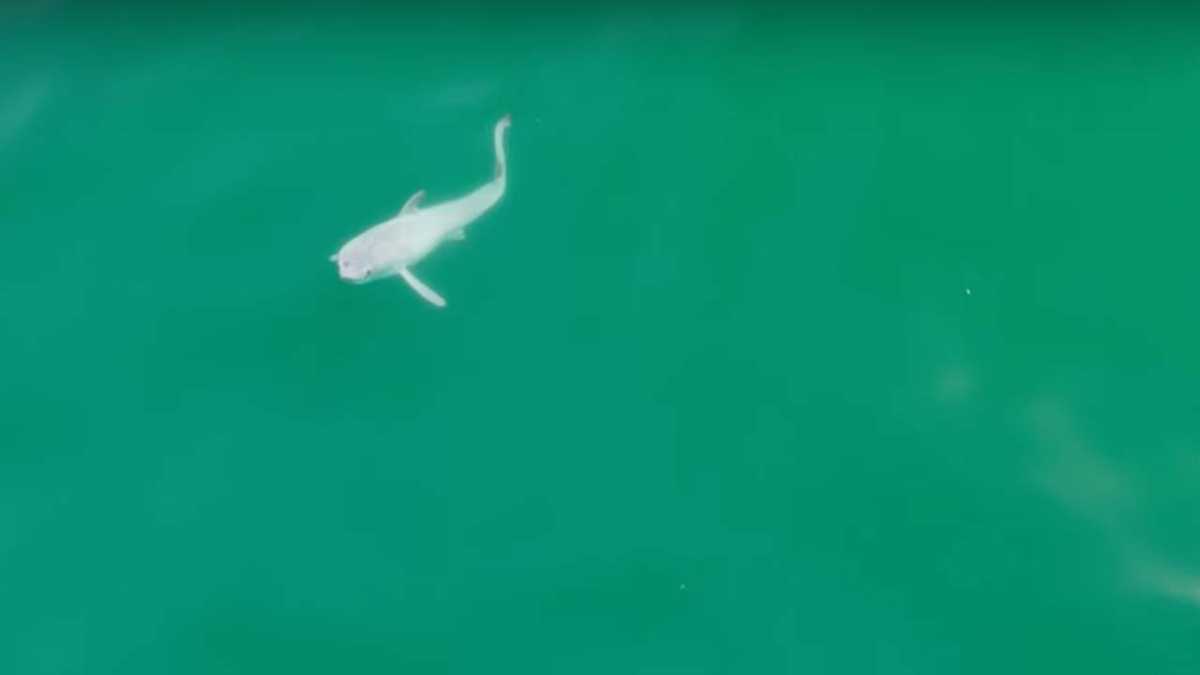News
Groundbreaking Footage Reveals Rare Sighting of Newborn Great White Shark Near Santa Barbara

Rare footage has emerged of a remarkable event in marine biology—a newborn great white shark has been spotted in the wild for the very first time. Wildlife filmmaker Carlos Gauna, also known as The Malibu Artist, and doctoral student Phillip Sternes managed to capture this incredible footage, presenting an exciting opportunity to further understand the birthing habits of these awe-inspiring oceanic giants.
The extraordinary sighting occurred during Gauna and Sternes’ routine shark observations near Santa Barbara on July 9, 2023. It was their drone camera that revealed the presence of a distinctive 5-foot shark, noticeably pure white in color instead of the typical gray and white pattern of great whites.
The researchers were particularly intrigued when they noticed a white layer being shed off the shark’s body as it swam. Sternes speculated, “I believe it was a newborn white shark shedding its embryonic layer.” To confirm their findings, the images captured by the camera were carefully examined under slow motion.
Shedding behavior in great white sharks has long been a mystery in the field of shark science. Gauna emphasized, “Where white sharks give birth is one of the holy grails of shark science. No one has ever been able to pinpoint where they are born, nor has anyone seen a newborn baby shark alive.” Therefore, observing the shedding behavior in this instance can provide invaluable information.
While the researchers acknowledge the possibility of skin conditions, they argue that no such conditions have ever been reported for great whites. Gauna added, “If that is what we saw, then that too is monumental because no such condition has ever been reported for these sharks.”
Gauna and Sternes provide several pieces of evidence to support their belief that the shark they observed was indeed a newborn great white. Firstly, female great white sharks give birth to live pups, with embryonic sharks feeding on unfertilized eggs for protein while in utero. Additionally, the mothers provide extra nourishment through a substance similar to “milk” secreted in the uterus. Sternes suggests, “I believe what we saw was the baby shedding the intrauterine milk.”
Secondly, the location of the sighting coincided with the presence of large, likely pregnant great white sharks. Gauna had previously observed pregnant sharks in the area, further bolstering the correlation. “It’s not a stretch to deduce where the baby came from,” Gauna noted.
Observing the shark’s size and shape, Sternes describes it as thin, short, and rounded, estimating its age to be mere hours or, at most, one day old. Lastly, the central California location, approximately 1,000 feet from the beach, has long been proposed as a potential birthing site for great white sharks. Sternes emphasized, “This may well be the first evidence we have of a pup in the wild, making this a definitive birthing location.”
Great white sharks are internationally recognized as an endangered species, emphasizing the need for further research to confirm whether these waters serve as a vital breeding ground. Sternes suggests, “If it does, we would want lawmakers to step in and protect these waters to help white sharks continue to thrive.”












